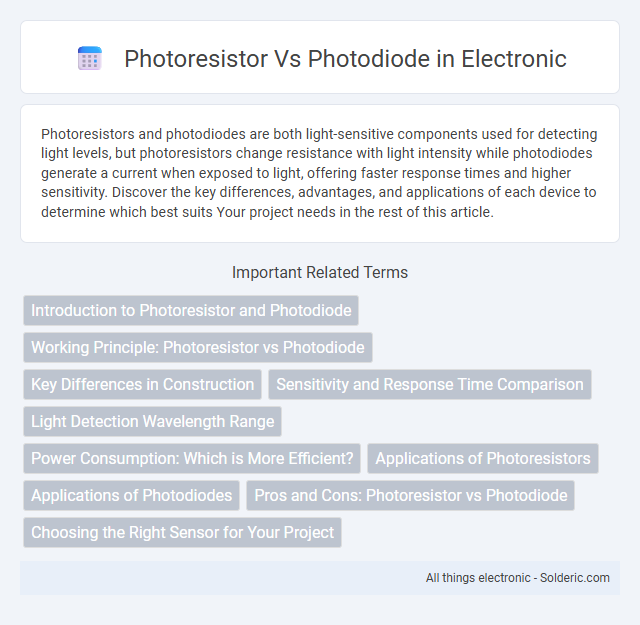Photoresistors and photodiodes are both light-sensitive components used for detecting light levels, but photoresistors change resistance with light intensity while photodiodes generate a current when exposed to light, offering faster response times and higher sensitivity. Discover the key differences, advantages, and applications of each device to determine which best suits Your project needs in the rest of this article.
Comparison Table
| Feature | Photoresistor (LDR) | Photodiode |
|---|---|---|
| Sensitivity | Moderate to low | High |
| Response Time | Slow (milliseconds to seconds) | Fast (nanoseconds to microseconds) |
| Spectral Range | Visible to near-infrared | Broad spectrum including UV to infrared |
| Linearity | Non-linear | Linear |
| Operating Principle | Resistance changes with light intensity | Generates current when exposed to light |
| Typical Applications | Light sensing, street lights, alarms | Optical communication, precise light measurement, medical devices |
| Cost | Low | Moderate to high |
| Power Consumption | Low | Very low |
Introduction to Photoresistor and Photodiode
Photoresistors, also known as LDRs (Light Dependent Resistors), change resistance based on light intensity, making them ideal for simple light-sensing applications. Photodiodes convert light into electrical current with high-speed response and sensitivity, suitable for precise light measurement and optical communication. Understanding these differences helps you select the right sensor for your light detection needs.
Working Principle: Photoresistor vs Photodiode
A photoresistor relies on the photoconductive effect, where its resistance decreases as light intensity increases, making it ideal for detecting ambient light levels. In contrast, a photodiode operates based on the photovoltaic effect, generating a current proportional to light intensity when exposed to photons, enabling faster and more precise light measurement. Your choice depends on whether you need a simple variable resistance sensor or a swift, accurate response for light detection.
Key Differences in Construction
Photoresistors, also known as LDRs, are made with a semiconductor material whose resistance changes based on light intensity, typically constructed using cadmium sulfide or similar compounds. Photodiodes are semiconductor devices built with a p-n junction designed to generate a current proportional to light exposure, offering faster response and higher sensitivity. Understanding these construction differences helps you choose the right sensor for applications requiring either simple light detection or precise optical measurements.
Sensitivity and Response Time Comparison
Photoresistors exhibit moderate sensitivity to visible light but have slower response times ranging from milliseconds to seconds, making them less suitable for rapid light changes. Photodiodes offer significantly higher sensitivity across a broader spectrum, including infrared, with response times in the nanosecond to microsecond range, enabling precise detection of fast-varying light signals. Your choice between these sensors depends on whether sensitivity or rapid response time is more critical for your application.
Light Detection Wavelength Range
Photoresistors typically detect a broader light wavelength range, from about 300 nm (UV) to 700 nm (visible light), making them versatile for general light sensing applications. Photodiodes have a narrower but more precise wavelength sensitivity, often tailored between 400 nm to 1100 nm, including visible and near-infrared spectra, which allows for faster and more accurate light detection. Your choice depends on whether you need wide-range sensitivity or high-speed, wavelength-specific measurement.
Power Consumption: Which is More Efficient?
Photoresistors consume more power than photodiodes because they rely on a resistive element that continuously draws current, whereas photodiodes generate current only when exposed to light, making them inherently more energy-efficient. Photodiodes operate with low bias voltage and produce measurable current with minimal power input, ideal for battery-powered or low-energy applications. Your choice should lean toward photodiodes when power efficiency is critical.
Applications of Photoresistors
Photoresistors are widely used in applications requiring sensitivity to ambient light levels, such as street lighting systems, light meters, and alarm devices. Their ability to change resistance based on light intensity makes them ideal for automatic brightness control in electronic displays and solar garden lights. Your choice of a photoresistor can enhance energy efficiency and responsiveness in various lighting and sensing technologies.
Applications of Photodiodes
Photodiodes are widely used in optical communication systems, enabling high-speed data transmission by converting light signals into electrical currents with rapid response times. They serve critical roles in medical devices such as pulse oximeters and glucose monitors, where precise light measurement ensures accurate readings. Industrial applications include smoke detectors and barcode scanners, leveraging photodiode sensitivity for reliable detection and reading performance.
Pros and Cons: Photoresistor vs Photodiode
Photoresistors offer low cost and simplicity with high sensitivity to visible light but have slower response times and less precision compared to photodiodes. Photodiodes provide fast response, high accuracy, and wide spectral response, ideal for high-speed and low-light applications, but require more complex circuitry and are generally more expensive. Choosing between photoresistors and photodiodes depends on application needs like speed, sensitivity, cost, and spectral range.
Choosing the Right Sensor for Your Project
Photoresistors and photodiodes differ significantly in response speed and sensitivity, making sensor selection crucial for your project's needs. Photoresistors offer a simple, low-cost solution ideal for detecting ambient light levels but have slower response times. Photodiodes provide higher precision and faster response, suitable for applications demanding accurate light measurement or rapid detection.
photoresistor vs photodiode Infographic

 solderic.com
solderic.com